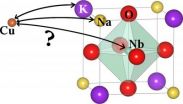Bioscience researchers defeating potato blight
2010-11-19
(Press-News.org) Researchers funded by the BBSRC Crop Science Initiative have made a discovery that could instigate a paradigm shift in breeding resistance to late blight – a devastating disease of potatoes and tomatoes costing the industry £5-6 billion a year worldwide. They will share this research with industry at an event in London later today (18 November).
Professor Paul Birch of the University of Dundee and his team at the Scottish Crop Research Institute (SCRI), the University of Dundee, and the University of Aberdeen have developed a new approach to breeding resistance to the mould-like organism Phytophthora infestans (P. infestans) that causes late blight.
Through their work on the interactions between potato plants and P.infestans Professor Birch and his team have come up with a completely new approach to breeding resistance to late blight in potatoes. This approach will be taken forward in a new project working with colleagues at The Sainsbury Laboratory in Norwich to identify resistance in potato plants that could then be used for breeding new resistant varieties. It is also hoped that it will be possible to combine resistance to late blight with resistance to nematodes (another serious problem for potato farming in the UK) in a single GM variety.
Professor Birch said "In the past we have tried to breed resistance to late blight by identifying plants that survive a period infection and could, in future generations, potentially give rise to resistant varieties. This approach is slow, resource intensive and requires a degree of luck that the resistance will last for any prolonged period. So far, all such resistances have been defeated because of the broad extent of variation in the population of P.infestans in the environment. With our discovery, we can use genetic analysis to identify plants for breeding that are inherently resistant to infection. When introduced into cultivated varieties, such disease resistance should be far more durable."
By studying the interactions between P. infestans and potato plants the team has identified proteins that are secreted by the invading pathogen and are essential for infection.
Professor Birch continued "We now know a lot more about how P.infestans gets round the potato plant's natural defences and therefore what it takes for the plant to resist infection. We can actually look at a potato plant's genetic makeup and say whether it will be sustainably resistant to late blight, which is a huge step forward. Whilst our approaches are suitable for breeding, in future we also hope to use a GM approach to produce a variety that is resistant to both blight and potato cyst nematode."
Dr Mike Storey, Head of Research and Development, AHDB - Potato Council said "Blight is a serious problem for the potato industry in the UK. We are working hard to raise grower awareness and ensure best practice to control the disease but we have the challenge of a continually changing pathogen population. What we need now is the application of this new research to improve variety resistance and identify new crop protection targets and integrate these approaches for sustainable control and to reduce the impact when blight does occur. This will be of great benefit to UK farmers and the economy."
Professor Janet Allen, BBSRC Director of Research and chair of the Global Food Security programme development board said "We know that high quality bioscience research is required if we are to have a sustainable supply of safe, affordable, healthy food to feed a growing world population. Late blight is a significant problem in the UK and elsewhere and so it is particularly good news that the fundamental research carried out under BBSRC's crop science initiative is providing opportunities to move towards application in new varieties."
INFORMATION: END
ELSE PRESS RELEASES FROM THIS DATE:
2010-11-19
Researchers have uncovered the genetic basis of remarkable broad-spectrum resistance to a viral infection that, in some parts of the world, is the most important pathogen affecting leafy and arable brassica crops including broccoli, cauliflower, cabbage, kale, swede and oilseed rape. They have tested resistant plants against a range of different strains of the virus taken from all over the world and so far, no strain has been able to overcome the resistance.
The research on the so-called Turnip mosaic virus (TuMV), led by Dr John Walsh of the University of Warwick and ...
2010-11-19
The transplant community was largely unaware of sub-standard transportation practices for donor organs until a number of fatal air crashes took the lives of transplant personnel, calling attention to procurement aviation safety. A new report highlighting the need for improved safety measures in organ procurement travel appears in the December issue of Liver Transplantation, a peer-reviewed journal published by Wiley-Blackwell on behalf of the American Association for the Study of Liver Diseases (AASLD).
In the U.S., the Organ Procurement and Transplantation Network (OPTN) ...
2010-11-19
OAKLAND, Calif. – Compared to women never on hormone therapy, those taking hormone therapy only at midlife had a 26 percent decreased risk of dementia; while women taking HT only in late life had a 48 percent increased risk of dementia, according to Kaiser Permanente researchers.
Women taking HT at both midlife (mean age 48.7 years) and late life had a similar risk of dementia as women not on HT, according to the study which appears in the Annals of Neurology. The study was funded in part by the National Institutes of Health.
Although previous research has shown that ...
2010-11-19
A protein known to exist in the brain for more than 30 years, called 5-lipoxygenase, has been found to play a regulatory role in the formation of the amyloid beta in the brain, the major component of plaques implicated in the development of Alzheimer's disease, according to researchers at Temple University's School of Medicine.
The researchers also found that inhibitors of this protein currently used to control asthma could possibly be used to prevent or treat Alzheimer's disease.
The researchers published their findings, "5-Lipoxygenase as Endogenous Modulator of Amyloid ...
2010-11-19
Retinitis pigmentosa is an inherited eye disorder characterized by progressive loss of vision that in many instances leads to legal blindness at the end stage.
In a ChIP-Seq based approach, the researchers identified a key regulatory role of the transcription factor Crx (Cone-rod homeobox) in the expression of retina-specific genes and thus described an important genetic basis for visual perception. In-depth analysis of Crx mediated regulation in photoreceptors with latest technology provided by Genomatix lead then to the identification of nonsense mutations in the human ...
2010-11-19
New stars are born in the Universe around the clock – on the Milky Way, currently about ten per year. From the birth rate in the past, we can generally calculate how populated space should actually be. But the problem is that the results of such calculations do not match our actual observations. "There should actually be a lot more stars that we can see," says Dr. Jan Pflamm-Altenburg, astrophysicist at the Argelander-Institut für Astronomie of the University of Bonn.
So, where are those stars?
For years, astronomers worldwide have been looking for a plausible explanation ...
2010-11-19
The casting sessions aren't just for movie stars, but what is involved in casting decisions that can launch fashion models to fame – or at the very least – to land a job? Stephanie Sadre-Orafai, a University of Cincinnati assistant professor and socio-cultural anthropologist, spent 11 months of fieldwork at a premiere casting agency in New York to uncover the decisions that happen behind the scenes of the glossy photos and slick commercials. Her research, "Polaroids and Go-Sees: Casting Encounters, Casting Epistemologies," was presented Nov. 17 at the 109th annual meeting ...
2010-11-19
HOUSTON – (Nov. 18, 2010) – Discovery of a fifth gene defect and the identification of 47 DNA regions linked to thoracic aortic disease are the subject of studies released this month involving researchers at The University of Texas Health Science Center at Houston (UTHealth).
In both studies, the investigators have identified alterations in the genetic material or DNA that affect the ability of smooth muscle cells, which line the aorta and other blood vessels, to contract. This can lead to a weakening of the wall of the aorta, the main blood vessel leading out of the ...
2010-11-19
Technical progress in the automobile industry is unbroken. But, the sector has still some hard nuts to crack: "Lead-free materials" is one of the challenges – hidden behind this challenge is a EU environmental directive which, based on a step-by-step plan, gradually bans all lead-containing materials and components from automotive vehicles – such as piezoelectric components. These elements are important for diesel engine injectors, for example, which control the supply of fuel to the combustion chamber.
The problem: Up to now lead-zirconate-titanate (PZT) is the material ...
2010-11-19
A short push on the light switch – and the whole ceiling lights up in a uniform and pleasant color. This "illuminated sky" is not available as yet, but researchers from all over the world are working on it flat out. The technology behind this marvel is based on organic light-emitting diodes, or OLEDs for short. These diodes use special molecules to emit light as soon as current passes through them. Although the first OLEDs have only recently become available, they are small and expensive. A flat disk with a diameter of eight centimeters costs around Euro 250. Experts of ...
LAST 30 PRESS RELEASES:
[Press-News.org] Bioscience researchers defeating potato blight

